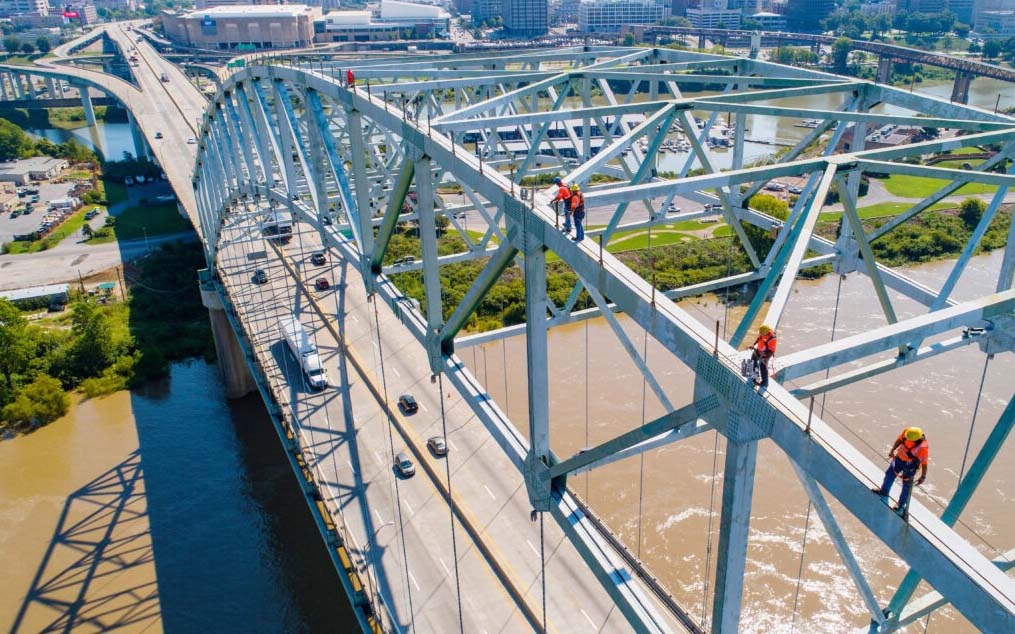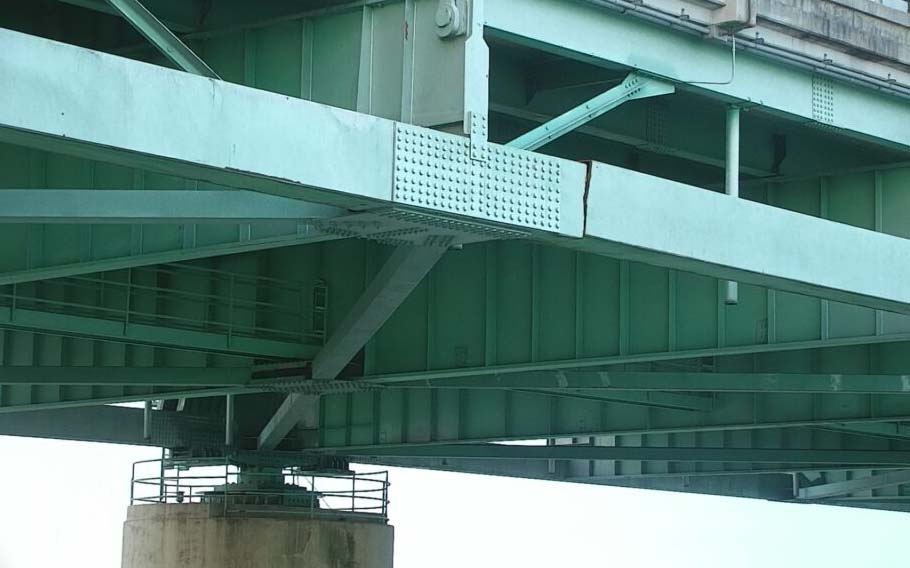Gov. Hutchinson calls for swift but safe repair of I-40 bridge after failed inspection
May 24-30, 2021
By Wesley Brown
Gov. Asa Hutchinson said during a press conference in Memphis on Tuesday that state highway officials in Arkansas and Tennessee will move as swiftly but as safely as possible to repair the Interstate 40 bridge that was shut down nearly two weeks ago.
Hutchinson, who was joined by Gov. Bill Lee of Tennessee and other top highway officials from both states at the 35-minute press briefing, said the two governors and their top advisors came together to find ways accelerate efforts to repair the 48-year-old bridge and get interstate traffic back flowing on one of the nation’s busiest transportation corridors.
“The purpose was simply to see if there was anything more we can do to speed up the process in a safe fashion, to make sure that the resources are there that we are expediting in every way we can that is consistent with safety,” said Hutchinson.
Last week, the Arkansas Department of Transportation (ARDOT) confirmed there was a failure in the inspection process which allowed evidence of damage to the I-40 Mississippi River Bridge to go unnoticed. State highway officials said they have fired the employee responsible for the oversight that has led to calls for federal intervention.
“From our investigation we have determined that the same employee who conducted the inspection in both 2019 and 2020 failed to carry out his responsibilities correctly,” ARDOT Director Lorie Tudor said in a statement. “This is unacceptable, and this employee has been terminated as of this morning.”
Hutchinson, during the press brief, also expressed the importance of the I-40 Corridor linking West Memphis to Memphis as critical to the flow of commerce in Arkansas, Tennessee and the surrounding region.
“Whenever you see a break in the commerce and whenever you see a defect in a bridge, you realize how dependent you are on the flow of commerce,” said Hutchinson. “And it really impacts the Arkansas side as some of the Arkansans who came over here today know that the delay is involved. We want to act with a sense of urgency, but we also depend on the safety of that bridge.
“And so, everything that we want to do will be moving with safety as the foremost principle involved. It is going to take some time, we are going to have to be patient and we are going to have to adjust some of our flow patterns, but we are going to work together to get this done as soon as possible,” said Hutchinson.
Following Tuesday’s press conference, TDOT announced that it had selected Omaha, Neb.-based Kiewit Corp. to perform the repairs to the I-40 bridge that will be done in two phases.
“We have requested that the Tennessee DOT perform a drone review of the I-55 Bridge over the Mississippi River to bring confidence to the public that the previous inspection was performed correctly and that it is currently in good condition,” ARDOT Director Lorie Tudor said at a local press conference in Little Rock.Arkansas and Tennessee highway officials said Phase I will add two 30-foot steel plates totaling 18,000 pounds each on either side of the fracture to strengthen the bridge for contractors and equipment to safely work on Phase II repairs. Kiewit has already mobilized and committed to working 24 hours a day until work is completed, and work platforms for the operations will go up this week.
Phase II will cut out and replace the damaged member and inspect the bridge for any additional concerns that need to be addressed before traffic returns to the bridge. Traffic cannot safely return to the bridge until both repair phases are completed, officials said. Weather permitting, TDOT states that while repairs could take several months but better estimates will be available as repairs progress.
TDOT also dedicated two inspection teams and drones to work on the I-55 Mississippi River Bridge and is using an “overabundance of caution” in reviewing new footage and previous inspection reports to verify the safety of the older bridge, officials said.
According to Tudor, earlier drone video footage that showed evidence of the bridge fracture in May 2019 was taken when Michael Baker International was performing an inspection of the cables and upper portion of the bridge, not the metal supports below. She said state highway officials will start changing the inspection process by adding redundancies, with further changes possible in the future.
“A multi-agency team, including two contracting firms and both Departments of Transportation, worked through the weekend to develop a plan to stabilize the structure, begin planning on a permanent repair, and have started reviewing contractors for the work,” explained Deputy Director Chief Engineer Rex Vines.
State highway officials said the team will also continue to inspect and investigate the bridge to be sure that any long-term damages, caused by the fracture or otherwise, are addressed. ARDOT said it expects to have a rough timeline for returning traffic to the bridge once a contractor has been selected and they have been consulted on the work needed.
The new revelation comes after ARDOT and the Tennessee Department of Transportation (TDOT) indefinitely down the Interstate 40 bridge over the Mississippi River, leaving thousands of motorists and truckers stranded or stuck in three-state traffic jams in the area surrounding one of the nation’s busiest transportation corridors.
Highway officials in Arkansas and Tennessee said last week they were working together to safely repair and reopen the Interstate 40 bridge as soon as possible (See story here). In addition, members of Arkansas and Tennessee’s all Republican congressional delegation urged U.S. Department of Transportation Secretary Pete Buttigieg to support the efforts to repair the I-40 bridge connecting the two states safely and efficiently.
“I appreciate Secretary Buttigieg’s willingness to discuss the I-40 bridge closure in more detail and his commitment to work with the Arkansas and Tennessee Departments of Transportation. This critical artery for the region must be safely reopened as soon as possible,” said Sen. John Boozman, Arkansas’ senior congressional official. “Working together, we can mitigate continued disruption to commerce and transportation needs along this corridor.”
Bridge over troubled waters
Ironically, DOT’s Federal Highway Administration (FHWA) on April 30 observed the 50th anniversary of its National Bridge Inspection Standards (NBIS), the basis for the federal program that helps to protect nearly 620,000 bridges across the country.
“For a half-century, NBIS standards have been at the core of federal infrastructure safety efforts,” Acting Federal Highway Administrator Stephanie Pollack said. “The data we collect under the program help keep bridges safe and identify areas where maintenance is needed before problems arise.”
Even as the number of bridges in the NBIS program has grown 588,735 to 618,456 over the last 20 years, the program has ensured these bridges are safe for the Americans who rely on them for travel and commerce.
The NBIS requires regular and thorough inspections of highway bridges by trained inspectors to detect potential structural problems early and to ensure maintenance efforts are being carried out. State departments of transportation inspect bridges, on average, once every 24 months and report the results to FHWA. If a bridge is rated as potentially unsafe, immediate actions are taken – including closure, prompt repairs, or load posting to restrict use by heavy vehicles.
In addition to specialized training for bridge inspectors, the program also requires the collection of bridge condition data for inclusion in FHWA’s National Bridge Inventory (NBI) which helps transportation officials make informed decisions about funding priorities.
FHWA officially adopted the NBIS regulations in 1971 after the collapse of the Silver Bridge in West Virginia. The bridge collapsed into the Ohio River in 1967 because of a crack in the bridge’s suspension chain. The tragedy, which cost the lives of 46 people, brought national attention to the issue of bridge condition safety and led to a systematic effort to ensure oversight at the national level.
“The NBIS is vital to bridge safety in our nation,” Pollack added. “The (Biden) administration’s American Jobs Plan proposes significant investment in our nation’s bridges to continue to improve their condition and make them even safer.”
President Joe Biden and Vice President Kamala Harris last week met with Republican and Democratic leaders at the White House following a weeklong U.S. roadshow to sell a $4.1 trillion infrastructure to the American people.
The first phase of the Biden administration’s long-term economic strategy includes a once-in-a-lifetime government job program to rebuild the nation’s crumbling infrastructure. The lion’s share of that $2.3 trillion of that American Jobs Plan investment would go toward upgrading 20,000 miles of highways and roads and repairing 10,000 of the nation’s oldest bridges. The plans also call for upgrading the nation’s energy grid, water systems, urban transit links, and rural broadband networks over the next decade.
Following a May 14 meeting with Biden and Harris, Republicans Senate Minority Leader Mitch McConnell of Kentucky and House Minority Leader Rep. Kevin McCarthy of California both said they are miles apart from reaching an agreement with Democrats on a nationwide infrastructure bill. Among many things, the Republican leaders said they could not support paying for the president’s American Jobs Plan by rescinding former President Donald Trump’s 2017 $1.8 trillion corporate tax cut.
To date, Arkansas all-Republican congressional delegation, which includes two senators and four U.S. representatives, has signed on to support President Biden’s mammoth infrastructure plan. In Tennessee, all eight of that state’s Republican congressmen and senators have also stated they would not support the Democratic president’s infrastructure and jobs plan.
ARDOT has dedicated a website o this closure of the I-40 Mississippi River Bridge. It is available here https://www.ardot.gov/divisions/public-inform ation/40-ms-river-bridge/
PHOTO CAPTIONS: (Photos provided by ARDOT)
1. The Arkansas Department of Transportation (ARDOT) confirmed last week that an image captured by an inspector’s drone video shows evidence of the fracture that caused the Interstate 40 Bridge to be shut down on May 11.
2. A routine inspection of the Interstate 40 Mississippi River (Hernando de Soto Bridge) discovered a mechanical fracture (pictured above) in a steel support beam that is crucial for the support of the 1.8-mile span.




